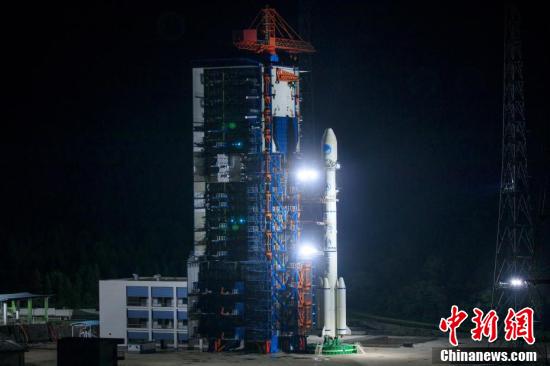You are using an out of date browser. It may not display this or other websites correctly.
You should upgrade or use an alternative browser.
You should upgrade or use an alternative browser.
China's Space Program News Thread
- Thread starter crazyinsane105
- Start date
- Status
- Not open for further replies.
China’s major space missions including a lunar sample return, Mars orbiter and rover and a modular space station could be facing delays due to an apparent issue affecting rockets required for launches.
The Long March 5 heavy-lift rocket is China’s most powerful launch vehicle and was designed to launch large spacecraft to geosynchronous orbits and planetary bodies. It was being prepared for a third flight in July, Yang Baohua, vice president of the China Aerospace Science and Technology Corporation (CASC), China’s main space contractor and developer of the Long March 5, announced in a Jan. 29 news conference in Beijing.
The mission would come two years after the . However that schedule appears to have slipped as the launch vehicle has yet to be delivered to the launch site, with knock-on effects possible for China’s major space plans.
China appears set to deorbit its Tiangong-2 space lab in the near future, according to a social media release from the China Manned Space Engineering Office (CMSEO).
CMSEO announced a quiz competition () Friday through its WeChat social media platform account, testing knowledge of launch times and mission details, to mark the ‘return of Tiangong-2’. No date for the planned re-entry was stated by CMSEO, which manages China’s human spaceflight endeavors.
Following the loss of contact with Tiangong-1 and subsequent of the 8.2-metric-ton spacecraft in April 2018, China announced in September last year that Tiangong-2 would be deliberately deorbited in 2019.
Lin Xiqiang, deputy director of the China Manned Space Engineering Office (CMSEO), stated that the space lab was functioning normally and would continue experiments and Earth observation until deorbiting in or after July 2019.
Following the loss of contact with Tiangong-1 and subsequent of the 8.2-metric-ton spacecraft in April 2018, China announced in September last year that Tiangong-2 would be deliberately deorbited in 2019.
Tiangong-1's "uncontrolled" re-entry was a farce by western media and "experts" to smear.
The "deliberate" deorbit of Tiangong-2 would be no difference from Tiangong-1's "uncontrolled" re-entry.
CNSA ONLY said "Tiangong-1 has stopped data service", it NEVER said "lost of telemetry", hugely different. It is just a PR improvement of CNSA by saying a word "deliberate" to shut the mouth of the smearers.
China carried out the controlled deorbiting of its Tiangong-2 space lab into the South Pacific, the China Manned Space Engineering Office (CMSEO) announced Friday.
The 8.6-metric-ton Tiangong-2 (‘Heavenly Palace 2’) reentered over the South Pacific Ocean Uninhabited Area at 9:06 a.m. Eastern using its own propulsion, following an engine burn 10 a.m. July 18 to lower the spacecraft’s perigee. Limited of the event was released shortly after.
CMSEO stated July 13 that it would end the Tiangong-2 mission July 19 Beijing time, in keeping with an announcement in September 2018 that the space lab would be deliberately deorbited this year.
The maneuver follows the high-profile and uncontrolled re-entry of Tiangong-1 in April 2018, having lost contact with and control of the experimental space lab in 2016.
China is developing a new type of recoverable satellite that is reusable and intends to use it for commercial purposes, according to China Aerospace Science and Technology Corp, a State-owned space giant in charge of the program.
The company said the new model will be designed to meet growing demand for space-based scientific experiments from a wide range of industries, including space science, agriculture, pharmaceuticals and energy. The first such satellite is scheduled to be launched in 2020, it said.
Zhao Huiguang, chief designer of recoverable satellites at the China Academy of Space Technology, said on Monday that researchers expect that 10 to 15 such satellites will be needed in the next decade by clients from home and abroad.
Zhao explained that the weightlessness inside the spacecraft will be beneficial to conducting many scientific experiments and recoverable satellites are the most suitable platform for such experiments.
Moreover, the research and development of new materials, electronic components and medicines have also benefitted from space-based experiments on such satellites, he said.
Compared with current recoverable satellites in China, the new type will feature reusability, better technology and stronger carrying capacity, Zhao said.
"Our current recoverable satellites are able to ferry 250 kilograms of scientific payloads back to Earth. The new model will be able to carry up to 600 kg," the designer said.
There's increasing interest in this sort of things from all quarters. The USAF has the X-37Bs which, at least part time, act as long endurance recoverable satellites. The Europeans are working on their SpaceRider.
Hendrik_2000
Lieutenant General
For the first time in China, a carrier rocket developed by a private company has successfully sent satellites into orbit. Click to find out the stories behind.
- Status
- Not open for further replies.

